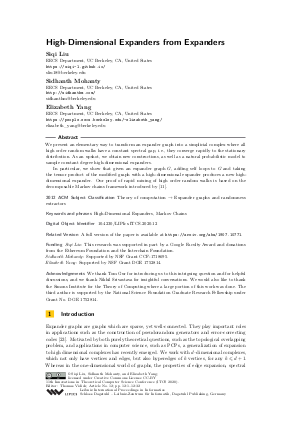High-Dimensional Expanders from Expanders
Authors Siqi Liu, Sidhanth Mohanty, Elizabeth Yang
-
Part of:
Volume:
11th Innovations in Theoretical Computer Science Conference (ITCS 2020)
Part of: Series: Leibniz International Proceedings in Informatics (LIPIcs)
Part of: Conference: Innovations in Theoretical Computer Science Conference (ITCS) - License:
 Creative Commons Attribution 3.0 Unported license
Creative Commons Attribution 3.0 Unported license
- Publication Date: 2020-01-06
File

PDF
LIPIcs.ITCS.2020.12.pdf
- Filesize: 0.98 MB
- 32 pages
Document Identifiers
Related Versions
-
A full version of the paper is available at https://arxiv.org/abs/1907.10771.
Subject Classification
ACM Subject Classification
- Theory of computation → Expander graphs and randomness extractors
Keywords
- High-Dimensional Expanders
- Markov Chains
Metrics
- Access Statistics
-
Total Accesses (updated on a weekly basis)
0Document
0Metadata
Abstract
We present an elementary way to transform an expander graph into a simplicial complex where all high order random walks have a constant spectral gap, i.e., they converge rapidly to the stationary distribution. As an upshot, we obtain new constructions, as well as a natural probabilistic model to sample constant degree high-dimensional expanders. In particular, we show that given an expander graph G, adding self loops to G and taking the tensor product of the modified graph with a high-dimensional expander produces a new high-dimensional expander. Our proof of rapid mixing of high order random walks is based on the decomposable Markov chains framework introduced by [Jerrum et al., 2004].
Cite As Get BibTex
Siqi Liu, Sidhanth Mohanty, and Elizabeth Yang. High-Dimensional Expanders from Expanders. In 11th Innovations in Theoretical Computer Science Conference (ITCS 2020). Leibniz International Proceedings in Informatics (LIPIcs), Volume 151, pp. 12:1-12:32, Schloss Dagstuhl – Leibniz-Zentrum für Informatik (2020)
https://doi.org/10.4230/LIPIcs.ITCS.2020.12
BibTex
@InProceedings{liu_et_al:LIPIcs.ITCS.2020.12,
author = {Liu, Siqi and Mohanty, Sidhanth and Yang, Elizabeth},
title = {{High-Dimensional Expanders from Expanders}},
booktitle = {11th Innovations in Theoretical Computer Science Conference (ITCS 2020)},
pages = {12:1--12:32},
series = {Leibniz International Proceedings in Informatics (LIPIcs)},
ISBN = {978-3-95977-134-4},
ISSN = {1868-8969},
year = {2020},
volume = {151},
editor = {Vidick, Thomas},
publisher = {Schloss Dagstuhl -- Leibniz-Zentrum f{\"u}r Informatik},
address = {Dagstuhl, Germany},
URL = {https://drops.dagstuhl.de/entities/document/10.4230/LIPIcs.ITCS.2020.12},
URN = {urn:nbn:de:0030-drops-116974},
doi = {10.4230/LIPIcs.ITCS.2020.12},
annote = {Keywords: High-Dimensional Expanders, Markov Chains}
}
Author Details
Funding
- Liu, Siqi: This research was supported in part by a Google Faculty Award and donations from the Ethereum Foundation and the Interchain Foundation.
- Mohanty, Sidhanth: Supported by NSF Grant CCF-1718695.
- Yang, Elizabeth: Supported by NSF Grant DGE 1752814.
Acknowledgements
We thank Tom Gur for introducing us to this intriguing question and for helpful discussions, and we thank Nikhil Srivastava for insightful conversations. We would also like to thank the Simons Institute for the Theory of Computing where a large portion of this work was done. The third author is supported by the National Science Foundation Graduate Research Fellowship under Grant No. DGE 1752814.
References
-
Nima Anari, Kuikui Liu, Shayan Oveis Gharan, and Cynthia Vinzant. Log-concave polynomials II: high-dimensional walks and an FPRAS for counting bases of a matroid. Proceedings of the 51st Annual ACM SIGACT Symposium on Theory of Computing, June 2019.

-
László Babai. Spectra of Cayley graphs. Journal of Combinatorial Theory, Series B, 27(2):180-189, 1979.

-
Avraham Ben-Aroya and Amnon Ta-Shma. A combinatorial construction of almost-Ramanujan graphs using the zig-zag product. SIAM Journal on Computing, 40(2):267-290, 2011.

-
Nathanaël Berestycki. Lectures on mixing times. Cambridge University, 2014.

- Michael Chapman, Nati Linial, and Yuval Peled. Expander Graphs-Both Local and Global. arXiv preprint, 2018. URL: http://arxiv.org/abs/1812.11558.
-
Irit Dinur and Tali Kaufman. High dimensional expanders imply agreement expanders. In 2017 IEEE 58th Annual Symposium on Foundations of Computer Science (FOCS), pages 974-985. IEEE, 2017.

-
Shai Evra and Tali Kaufman. Bounded degree cosystolic expanders of every dimension. In Proceedings of the forty-eighth annual ACM symposium on Theory of Computing, pages 36-48. ACM, 2016.

-
Joel Friedman. A proof of Alon’s second eigenvalue conjecture. In Proceedings of the thirty-fifth annual ACM symposium on Theory of computing, pages 720-724. ACM, 2003.

-
Mikhail Gromov. Singularities, expanders and topology of maps. Part 2: From combinatorics to topology via algebraic isoperimetry. Geometric and Functional Analysis, 20(2):416-526, 2010.

-
Shlomo Hoory, Nathan Linial, and Avi Wigderson. Expander graphs and their applications. Bulletin of the American Mathematical Society, 43(4):439-561, 2006.

-
Mark Jerrum, Jung-Bae Son, Prasad Tetali, Eric Vigoda, et al. Elementary bounds on Poincaré and log-Sobolev constants for decomposable Markov chains. The Annals of Applied Probability, 14(4):1741-1765, 2004.

-
Tali Kaufman, David Kazhdan, and Alexander Lubotzky. Ramanujan complexes and bounded degree topological expanders. In 2014 IEEE 55th Annual Symposium on Foundations of Computer Science, pages 484-493. IEEE, 2014.

- Tali Kaufman and David Mass. High dimensional random walks and colorful expansion. arXiv preprint, 2016. URL: http://arxiv.org/abs/1604.02947.
- Tali Kaufman and Izhar Oppenheim. High order random walks: Beyond spectral gap. arXiv preprint, 2017. URL: http://arxiv.org/abs/1707.02799.
- Tali Kaufman and Izhar Oppenheim. Construction of new local spectral high dimensional expanders. arXiv preprint, 2019. URL: http://arxiv.org/abs/1710.05304.
-
David A Levin and Yuval Peres. Markov chains and mixing times, volume 107. American Mathematical Soc., 2017.

-
Nathan Linial and Roy Meshulam. Homological connectivity of random 2-complexes. Combinatorica, 26(4):475-487, 2006.

- Alexander Lubotzky. High dimensional expanders. arXiv preprint, 2017. URL: http://arxiv.org/abs/1712.02526.
-
Alexander Lubotzky, Ralph Phillips, and Peter Sarnak. Ramanujan graphs. Combinatorica, 8(3):261-277, 1988.

-
Alexander Lubotzky, Beth Samuels, and Uzi Vishne. Explicit constructions of Ramanujan complexes of type Ad. European Journal of Combinatorics, 26(6):965-993, 2005.

-
Omer Reingold, Salil Vadhan, and Avi Wigderson. Entropy waves, the zig-zag graph product, and new constant-degree expanders. Annals of mathematics, pages 157-187, 2002.

-
Horst Sachs. Über teiler, faktoren und charakteristische polynome von graphen. Teil I. Wiss. Z. TH Ilmenau, 12:7-12, 1966.

-
Michael Sipser and Daniel A Spielman. Expander codes. In Proceedings 35th Annual Symposium on Foundations of Computer Science, pages 566-576. IEEE, 1994.

